Striking Against Colonialism: The General Strike in the Irish and Algerian Revolutions
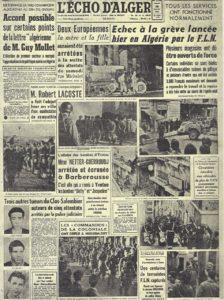 By Dónal Hassett
By Dónal Hassett
The recent Centenary of the Irish General Strike of 1920 has underlined the potential power of a movement that can marshal the forces of labour behind the cause of resisting colonial repression and securing national liberation.
The co-ordinated withdrawal of labour has long been an important weapon in the arsenal of those opposing colonial rule in different geographical and historical contexts. However, if the strategic potential of the general strike was almost universal across imperial possessions, the ability of activists to implement it effectively was not.
The weight of the repressive apparatus of the colonial state and the discriminatory exclusion of certain categories of its subjects was never equally distributed within and between colonial Empires.This would have major implications for those seeking to deploy the General Strike to further the anti-colonial cause. The comparison between Ireland and Algeria is particularly illustrative.
Neither Colony Nor Metropole
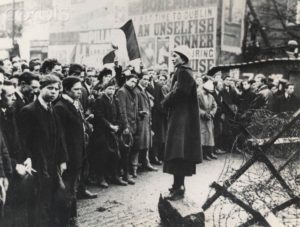
Algeria and Ireland occupied unique but parallel positions within the French and British Empires. Both were not legally considered colonies but rather integral parts of the imperial metropole.
Their histories had been shaped by the mass importation of settlers, the expropriation of land and the imposition of new cultural and religious norms. They were, at least in theory, governed directly from the respective imperial capitals and represented in Parliament.
However, the fiction of integration was evident on the ground in both Ireland and especially in Algeria. Ireland was the only part of the United Kingdom to have a militarised police force in the form of the Royal Irish Constabulary and the highly centralised administration in Dublin Castle was more redolent of British institutions in African and Asian colonies than anything in Cardiff or Edinburgh.[1]
Both Algerian and Irish nationalists used the tactic of general strikes during their anti-colonial struggles.
By 1920, much of the country was in turmoil as the elected representatives of the majority of the Irish people rejected British rule and pledged their allegiance to an alternative separatist Parliament, the first Dail.
The disparity between the rhetoric of integration and the everyday reality of colonial rule was far more extreme in Algeria. Unlike the Irish, the Algerians had been relegated to the status of subjects, not citizens, for most of the colonial period and denied many basic civil and political rights. The combination of the hard-fought battles for Catholic emancipation, electoral reform and female suffrage meant that 1918 saw Sinn Féin triumph with an electorate of all men over 21 and women over 30. Victory at the ballot box was simply not an option for Algerian nationalists.
Although Algerians were eventually granted a form of French citizenship in the wake of World War Two, this did not mean equality with colonial settlers or the citizens of metropolitan France.
The franchise was denied to Algerian women until 1958 and the electoral system was designed to ensure that a settler’s vote was worth eight times that of an Algerian. In any case, the French authorities had no qualms about banning political parties, stuffing ballot boxes and rigging elections in the colony.[2]
Nor were they reticent about the use of brutal tactics in their efforts to crush the armed rebellion of the Front de Libération Nationale (FLN), launched in 1954. While the atrocities and abuses perpetrated by Crown Forces during the Irish Revolution are well-documented, they pale in comparison to the systemic use of torture, napalm, blanket bombing and mass internment in wartime Algeria.
Algerians enjoyed significantly fewer rights than their Irish equivalents and even these limited rights were more likely to be breached, often with dire consequences. This would shape both the form the anti-colonial struggle would take and the role labour would play in it.
Labour and Nationalism: Co-operation, Co-option or Circumvention
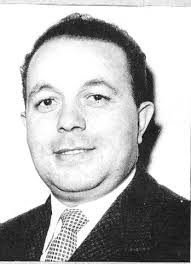
In order to effectively mobilise the power of labour against the occupying forces, the nationalists in both Ireland and Algeria would have to either co-operate with, co-opt or circumvent the existing trade union movement.
In Ireland, the presence of a powerful indigenous trade union movement, which had staked out a central role for itself in the politics of the island, meant that simply bypassing labour was not an option.
The foundation of the Irish Transport and General Workers’ Union in 1909 and its rapid expansion throughout the revolutionary period confirmed the importance of labour to mass politics in Ireland.
The nationalist movement, convinced that a cross-class coalition with the tacit support of some elements of the Catholic Church was essential to achieving its immediate goal of independence, was reluctant to endorse most forms of class politics.
The Irish labour movement was independent of Sinn Fein, whereas the Algerian trade union the UGTA, was part of the National Liberation Front movement.
It was, however, happy to ally itself to labour to rally working people behind specific campaigns that (at least nominally) transcended class and neither totally excluded nor wholeheartedly embraced calls for social revolution.
For its part, the labour movement outside of Protestant Northeast, although jealous of its organisational independence, seemed increasingly willing to weigh in behind radical nationalism in a push for an end to Empire in Ireland. Indeed, an off-shoot of the trade union movement, the Irish Citizen Army, had participated in the armed insurrection of 1916, its leader James Connolly was executed and several leading labour activists, such as William O’Brien and Cathal O’Shannon were interned in the Rising’s aftermath.[3]
Unlike their equivalents in Ireland, the nationalists in the Algeria of the 1950s could not count on a pre-existing labour movement to mobilise workers in a general strike against colonial repression. Trade unions in the colony, by and large, remained subservient to the national organisations in Paris.
The repressive legal regime that governed Algerians limited their rights to participate in trade union action and the discrimination that permeated colonial society saw them and their issues largely excluded from the mainstream trade union organisations.[4]
Eager to mobilise the people, the FLN set about both subsuming existing political or civil society movements into their organisation and building mass organisations of their own. The driving intellectual force behind this strategy, Abane Ramdane, had read about the Irish struggle while in jail in France and was an admirer of Eamon de Valera.[5]
The policy he advocated resulted in the foundation of the Union Générale des Travailleurs Algériens (General Union of Algerian Workers- UGTA) in February 1956. The organisation circumvented the existing trade unions, recruiting heavily among the Algerian workers in the cities, though making few inroads among the huge population of rural labourers. The UGTA, the key force for the mobilisation of Algerian workers, was not, like Irish labour, an ally of the nationalist movement, but rather an integral part of the FLN, bound to follow its strategy and the orders of its leadership.
The Goals of the General Strikes: Incremental vs Insurrectional.
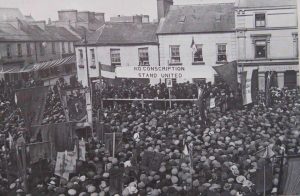 While over the course of their respective revolutionary periods, Algerian and Irish nationalists would both mobilise labourers in general strikes designed to contest colonial rule, the strategies that informed and the goals that defined these strikes were radically different.
While over the course of their respective revolutionary periods, Algerian and Irish nationalists would both mobilise labourers in general strikes designed to contest colonial rule, the strategies that informed and the goals that defined these strikes were radically different.
In Ireland, the two great general strikes of April 23rd 1918 and April 13th 1920, brought the labour movement (outside of the Protestant and unionist dominated Northeast) together with various nationalists and the hierarchy of the Catholic Church, on a shared platform that challenged British rule by demanding specific concessions.
In 1918, the focus was on resisting conscription, refuting the right of the British Empire to force Irishmen to fight on the battlefields of the Great War. It sought to impress on the administrators of the British State in Ireland and the political class and electorate of Great Britain itself that any effort to shove conscription down the throats of the Irish would make the kingdom’s second island ungovernable.
General strikes in Ireland in 1918 an 1920 demanded specific concessions, but in Algeria they demanded the collapse of the whole French colonial system.
The action rallied workers, supported not just by their unions and the clergy but also by many employers, against a policy that was seen as particularly unjust and symptomatic of the broader exploitative nature of the Anglo-Irish relationship. It was not, however, a strike that sought, in and of itself, to bring the edifice of British rule crashing down.
Although the situation had further radicalised by the time Irish workers downed tools once more in support of the General Strike of 1920, much of the same logic underpinned their action.
Once again, the labour movement came together with the nationalists of Sinn Féin, the Catholic Church and the employers to mobilise around a specific issue that neither expressly precluded nor included a call for social transformation.
The work stoppage was once again a means of communicating to Dublin Castle, Whitehall, Westminster and the British electorate that the imprisonment of political activists, who had gone on hunger strike, was not the solution to the Irish question. While labour activists in some parts of the country set up Workers’ Councils, even using the term Soviet,[6] the main focus of the strike remained the call for the liberation of political prisoners and the protection of the lives of the republican hunger-strikers.[7]
Many of those who withdrew their labour hoped their action would hasten the end of British rule. Some hoped it with also bring the class system tumbling down with it. These were not, however, the stated goals of the strike action. The General Strikes in Revolutionary Ireland were nationalist in their tone, domestic in their target audience and incremental in their strategy.
In an Algeria where both the intransigence of the French state and its willingness to use the most brutal forms of violence made concessions unlikely, the general strike would take a very different form.
The newly-founded Algerian union, the UGTA, decided to flex its muscles with a first general work stoppage on July 5th 1956 to mark the 126th anniversary of the French invasion of the colony. In contrast to their brethren in Ireland, the Algerian workers did not have any specific demands but rather framed their action as an ‘insurrectional strike that will, for once and for all, free us from colonial oppression’.[8]
Although largely limited to major urban areas, the strike was an important show of strength for the nascent union, indicating support for the FLN its revolutionary cause among the population.
This first strike underlines how different the dynamics of class, ideology and politics were in the Algeria of the War of Independence from the Ireland of the revolutionary period. The impoverishment of the Algerian population at the hands of French colonialism meant that the FLN paid less attention than the Irish nationalists to assuaging the fears of property owners about the mobilisation of labour.
The movement’s absorption or elimination of rival political organisations saw it exercise an effective monopoly over the political action of Algerians and freed it from the need to build coalitions.
Finally, the FLN’s embrace of an explicitly anti-imperialist politics that advocated the implementation of an Algerian and Islamic form of socialism meant it was far more willing to use the tactics and the language of social revolution. The July 5th strike in Algeria, although more limited in its geographical reach, was more ambitious and radical in its rhetoric than its equivalents in the Ireland of April 1918 or April 1920.
As the FLN found itself increasingly under pressure militarily from the French, the nationalists looked beyond Algeria and France to the world stage to garner support for their cause. While the Irish had tried (and largely failed) to secure diplomatic recognition overseas during their independence struggle, the FLN saw the ‘internationalisation’ of the Algerian question as a key strategy to bolster their cause.[9]
They sought to profit from both the existence of the United Nations as a global forum and the growing presence within its National Assembly of newly independent and anti-colonial African and Asian states.
The movement sent representatives to New York to coordinate a campaign for Algerian independence and were favourably received by some of the Irish delegation, especially a young Conor Cruise O’Brien.[10]
Back in Algeria, the FLN’s key strategists, sought to focus the world’s attention on their struggle by shifting the conflict away from the isolated mountains and into the heart of the major cities.[11] There, the general strike could be deployed to bring the economic life of urban Algeria to a halt and bring the Algerian Question to the front pages of the international press.
In November 1956, the Committee of Coordination and Execution, the driving force of the FLN, planned an eight-day strike at the end of January/beginning of February 1957, designed not only to coincide with a debate on the issue of Algeria at the UN but also to rally the urban masses to the cause, solidify its monopoly on leadership of the Algerian nationalist movement.[12]
On January 28th, the first day of the work stoppage, the Arab quarters of the major cities were deserted, as the Algerian population complied with the FLN’s strike order, whether motivated by conviction, fear of reprisal or a mix of both.
The capital, Algiers, as the point of entry for most international journalists writing on events in the colony, became the focal point for the all-important coverage of the strike, even though its impact was felt throughout the territory.
The planned duration of the strike and the broadness of its aims indicated a radical challenge not just to the existing political order but also to the related economic order in the colony. The general strikes in Algeria were revolutionary in their tone, international in their target audience and insurrectionary in their strategy.
The Response of the Authorities: Concessions vs Coercion
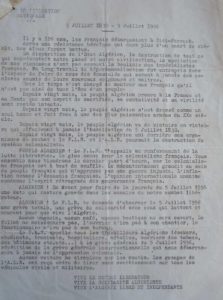 The Irish General Strike of 1920 was a resounding success for the nationalist movement. The immense pressure exercised by the combined forces of labour, nationalism, civil society and the Church secured an immediate and important concession from the British authorities in Ireland: the release of large numbers of republican prisoners.
The Irish General Strike of 1920 was a resounding success for the nationalist movement. The immense pressure exercised by the combined forces of labour, nationalism, civil society and the Church secured an immediate and important concession from the British authorities in Ireland: the release of large numbers of republican prisoners.
It underlined the extent to which British repressive tactics were severe enough to provoke outrage and engender solidarity among the Irish but not sufficiently coercive as to crush the movement outright.[13]
This dynamic, undoubtedly linked to the position of the Irish within the imperial hierarchy as a white colonial population that enjoyed formal legal equality with the British but who were subject to specific forms of state violence, fuelled the rise of a cross-class coalition willing to mobilise en masse against the authorities.
While the strike did not immediately bring an end to British rule- this was never its goal- it reinforced the sense that Ireland was ungovernable, further diminishing the desire of the British state and electorate to spend valuable financial, human and political capital on shoring up a collapsing order.
Whereas the British authorities backed down in the face of general strikes, the French in Algeria crushed them by military force.
The Algerian General Strike of 1957 met with a completely different response. Faced with this unprecedented challenge to its authority at a delicate time for its international reputation, the French government and its agents in Algeria decided that the strike must be crushed at all costs.
In Algiers, the epicentre of the movement, responsibility for the security of the city had effectively been devolved to the notorious parachute regiment, which quickly set about locking down the Casbah, a FLN stronghold. In scenes immortalised not just in Gillo Pontecorvo’s classic film The Battle of Algiers but also in contemporaneous newsreels produced by the French Army, the paras sought out Algerian shop-owners and forced them to re-open their businesses at gun point.[14]
Workers were rounded up and compelled to return to their posts. The French forces seized the opportunity to arrest hundreds of nationalist activists, crushing the nascent UGTA union in the colony’s capital. The widespread use of torture by the Army in Algeria at the time meant that many of those captured suffered horrific trauma at the hands of the French.
The strike was effectively crushed by the brute force of the French military, its leaders arrested and in some cases executed by the French.[15] Following the defeat of the strike, the FLN dedicated its energies to a campaign of bombings and assassinations in the city designed to attract global attention.
The so-called ‘Battle of Algiers’ would also end in military defeat at the hands of the paras, but not before substantial damage was done to France’s claim to be an agent of peace and progress in its North African colony.
If the Irish propaganda campaign around atrocities was an embarrassment to the British in the 1920s, the global condemnation of French brutality was an existential threat to colonial rule in the Algeria of the 1950s and 1960.
The post-WWII effort to recast Empire as a humanitarian and developmentalist project, the scepticism of the two global superpowers about older systems of colonial rule and the enhanced importance of post-colonial states on the global scene meant that, while the repression may have been far more extreme in Algeria than in Ireland, it came at a far greater cost to the French than to the British.
The General Strikes in National Memory Narratives
The General strikes in Ireland and in Algeria may have differed in tone, form and outcome, but they came to share a broadly similar place in the narratives of both post-independence states.
In Ireland, the emergence of a conservative polity dominated by parties who traced their legitimacy back to the military and political struggle of the nationalist movement meant that the strikes (and the labour movement more broadly) were overshadowed by the emphasis on the actions of Sinn Féin and the IRA. In Algeria, the post-colonial one-party state was ruled by figures who had spent much of the war in exile and who viewed the strike as a strategic error.
In both Ireland and Algeria the general strikes became footnotes in a history that glorified the military struggle for independence.
It became a footnote in the narrative of the FLN’s heroic military resistance in the Battle of Algiers. The sidelining of the strikes served not only to minimise the role of organised labour in the respective national struggles but also to occlude the centrality of women as key organisers and participants in this form of political action.[16]
Furthermore, the thorny question of how workers who remained loyal to the French and British states, the vast majority of both European settlers in Algeria and Protestants in Ulster, reacted to the strikes was ignored. The story of the strikes was made to fit the dominant and often exclusionary narratives promoted by the new ruling elites.
While nationalist movements in both Ireland and Algeria sought to mobilise labour against colonial rule in their respective countries, the form their strikes took, the reactions they provoked and the outcomes they secured differed radically.
The contrasts and commonalities that define the Irish and Algerian General Strikes remind us of the benefit of cross-colonial comparisons in helping us understand our own past and how we remember it in a broader, international perspective.
Dr Dónal Hassett is a Lecturer in French at University College Cork who teaches on topics relating to the history, the politics and the societies of France and the wider Francophone world.
References
[1] Gearóid Ó Tuathaigh, “Exemplar, Outlier, Impostor? A Reflection on Ireland and the Discourses of Colonialism,” in The Shadow of Colonialism on Europe’s Modern Past, Rósín Healy and Enrico Del Lago (eds.), (Palgrave: London, 2019), 36-53, 39.
[2] James MacDougall, A History of Algeria, (Cambridge University Press: Cambridge, 2017), 84 and 88.
[3] Pádraig Yeates, “HAVE YOU IN IRELAND ALL GONE MAD’ – the 1918 General Strike Against Conscription,” published by Century Island, November 2019, 13. Available here: https://www.rte.ie/centuryireland//images/uploads/content/Ed125-ConscriptionStrike1-Yeates-UpdateNov2019.pdf
[4] Algerians’ rights to participate in the labour movement were restricted under the 1884 law governing trade unions, Loi relative à la création des syndicats professionnels, Journal Officiel, 22 Mar 1884, 1577-1578.
[5] Bélaïd Abane, L’Algérie en Guerre: Abane Ramdane et les fusils de la rébellion, (L’Harmattan: Paris, 208), 216.
[6] Conor Kostick, “The Irish Working Class and the War of Independence,” Irish Marxist Review, Vol.4, No.14, (2015), 18-28, 25.
[7] John Dorney, “The General Strike and Irish Independence,” The Irish Story, 06 June 2013, https://www.theirishstory.com/2013/06/06/the-general-strike-and-irish-independence/#.XqBp2MhKjIU
[8] “Tract du FLN à l’occasion de la grève générale du 5 juillet 1956,”, Archives Nationales d’Outre-Mer, available online in the online depository of the CVCE: https://www.cvce.eu/obj/tract_du_fln_5_juillet_1830_5_juillet_1956-fr-e7f4369e-0947-4de0-9527-fb0ce0102452.html.
[9] See Matthew Connelly’s excellent book A Diplomatic Revolution: Algeria’s Fight for Independence and the Origins of the Post-Cold War Era, (Oxford University Press: Oxford, 2003).
[10] Christophe Gillissen, “Ireland, France and the Question of Algeria at the United Nations, 1955-62,” Irish Studies in International Affairs, Vol. 19 (2008), 151-167, 155.
[11] Jeffrey Byrne, Mecca of Revolution: Algeria, Decolonization, and the Third World Order, (Oxford University Press: Oxford, 2016), 57.
[12] BenYoucef Ben Khedda, “Contribution à l’historique du FLN,” in Les Archives de la révolution algérienne, Mohammed Harbi (ed.), (Jeune Afrique: Paris, 1981), 312-321, 313.
[13] John Dorney, “The Hunger Strike and General Strike of 1920,” The Irish Story, 13 April 2020, https://www.theirishstory.com/2020/04/13/the-hunger-strike-and-general-strike-of-1920/#.XqBZMMhKjIU
[14] Les Actulaités Françaises, 06/02/1957, Institut National Audiovisiuel, https://www.youtube.com/watch?v=hNfcQGLdWVs.
[15] MacDougall, History of Algeria, 214.
[16] For an exploration of place of women in the narratives of both Revolutions see: Natalya Vince, Our Fighting Sisters: Nation, memory and gender in Algeria, 1954–2012, (Manchester University Press: Manchester, 2015) and Linda Connolly, “Honest Commemoration: Reconciling women’s ‘troubled’ and ‘troubling’ history in centennial Ireland,” MUSSI Working Paper Series, no.9, available here: http://mural.maynoothuniversity.ie/11108/.